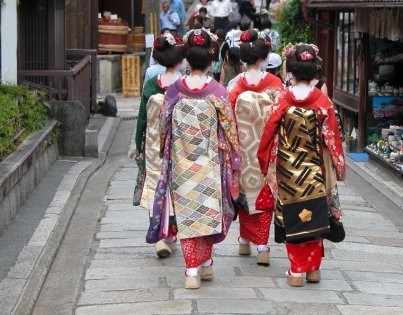 Kyoto is a safe and friendly place for visitors, with low rates of crime and spotless streets. The country suffers from seasonal typhoons June through October and there are some dos and don't to observe, but most tourists get by without incident.
Kyoto is a safe and friendly place for visitors, with low rates of crime and spotless streets. The country suffers from seasonal typhoons June through October and there are some dos and don't to observe, but most tourists get by without incident.The Japanese are polite and conservative, almost without exception, and although there is a certain amount of leeway for the outgoing nature of foreigners, adhering to basic rules will see things go more smoothly.
Japanese bow on greeting, with the lower the bow the greater the respect shown. The removal of shoes before entering shrines, and sometimes even restaurants, is mandatory, while tipping is not required.
The yen (JPY) is the unit of currency in Japan, with bills ranging from 10,000 yen down to 1,000 yen and coins spanning 500 yen to 1 yen. Banks have the best exchange rates, but if you want to be prepared it is better to acquire currency at the airport in Japan as opposed to in your home country.
ATMs are everywhere in Kyoto although credit cards are not as commonly used as in the US. On expense, Kyoto is almost on par with Tokyo for everything from hotels to eating out although there are good deals to be had in the markets on handicrafts and food.
June and July are the wettest months, while August and September are the hottest, have the fewest crowds and see restaurants along the Kamo River go alfresco. December through February is cold but not too wet and when good deals can be had on rooms.
Many visitors to Kyoto specifically aim to get here either in April (for the spring cherry blossoms) or in November (for the colorful fall foliage) and at both of these times the place is especially crowded.
Kyoto has an excellent and efficient public transport network, plus it is okay for getting about on foot outside of the summer months. Many of the main attractions are contained within small districts where the best way to get around is on foot or by bicycle. There are bike rental places all over.
The Kyoto subway system is excellent for inner-city travel, with over two-dozen stations making travel between districts less time consuming than taking a bus. Tickets are quite expensive one-way, yet daily zoned passes can be had.
You can also make use of cheaper Kyoto buses. The Chin-Chin bus is the best option for visitors, leaving the main Kyoto Station every 10 minutes and taking in the main Kyoto attractions. Taxis are metered and efficient, yet expensive, and can be flagged or hired from stands at tourist spots.
There is no airport in Kyoto, although Osaka is not far away and has two airports. Kansai International Airport (UKY) is the main one in Osaka and has direct Haruka Limited Express trains to Kyoto from its on-site train station, Kansai Airport Station. Buses also run from the airport in a couple of hours, while the Shinkansen (bullet train) runs regularly from Tokyo in just over two hours.
Population: 1.5 million
Spoken languages: Japanese, minimal English
Electrical: 110 Volts, 60 Hertz
Phone/calling code: + 81 75
Find more information about Kyoto and hotels in the area:
Kyoto hotels | Japan hotels